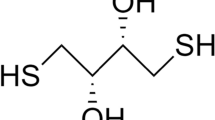Abstract
Course treatment with mexidol in a dose of 25 mg/kg for 3 days decreased activities of aspartate transaminase and creatine phosphokinase in the plasma on day 3 after the incidence of skin ischemia (by 1.3 and 1.66 times, respectively). Under these conditions the index of cytolysis decreased by 1.3 times. Therefore, mexidol prevented progression of necrotic processes in the skin. Mexidol therapy of animals with skin ischemia restored the reserve capacity of systems for energy supply and antioxidant defense. The systems of NADH-ubiquinone reductase and succinate-ubiquinone reductase served as the targets for the action of mexidol. Mexidol significantly decreased the damaging effect of reactive oxygen species. Dermatoprotective properties of mexidol were associated with its influence on the energy supply system (regulation of enzyme activity in the electron transport chain, ubiquinone metabolism) and antioxidant defense.
Similar content being viewed by others
REFERENCES
S. V. Vasil’eva, V. P. Galenko-Yaroshevskii, Yu. Yu. Fedchenko, et al., Byull. Eksp. Biol. Med., Suppl. 3, 97–101 (2002).
P. A. Galenko-Yaroshevskii, I. S. Chekman, and N. N. Gorchakova, Essays on Pharmacology of Preparations for Metabolic Therapy [in Russian], Moscow (2001).
V. V. Gatsura, V. V. Pichugin, L. N. Sernov, and L. D. Smirnov, Kardiologiya, No. 11, 59–62 (1996).
A. V. Zadorozhnyi, V. A. Popkov, V. P. Galenko-Yaroshevskii, et al., Byull. Eksp. Biol. Med., 138, No.9, 290–294 (2004).
L. D. Smirnov and K. M. Dyumaev, Directed Search for Physiologically Active Substances [in Russian], Riga (1987), pp. 5–44.
L. O. Chernukhina, G. V. Donchenko, and V. M. Kovalenko, Ukr. Biokhim. Zh., No. 4, 514–518 (1974).
N. Chen, Y. Liu, and L. Holtzman, J. Lab. Clin. Med., 136, No.1, 58–65 (2000).
G. P. Littarru, D. Jones, J. Scholler, and K. Folkers, Int. J. Vit. Nutr. Res., 42, No.1, 127–128 (1972).
Author information
Authors and Affiliations
Additional information
__________
Translated from Byulleten’ Eksperimental’noi Biologii i Meditsiny, Vol. 139, No. 2, pp. 170–174, February, 2005
Rights and permissions
About this article
Cite this article
Galenko-Yaroshevskii, V.P., Bagmetova, E.N., Fil’chukova, I.A. et al. Antihypoxic and Antinecrotic Effect of Mexidol in Skin Ischemia. Bull Exp Biol Med 139, 202–206 (2005). https://doi.org/10.1007/s10517-005-0248-8
Received:
Issue Date:
DOI: https://doi.org/10.1007/s10517-005-0248-8




